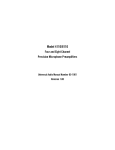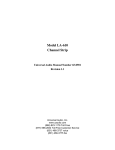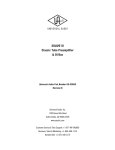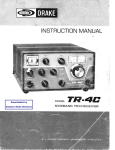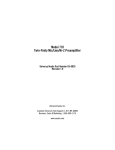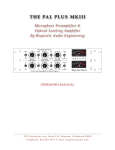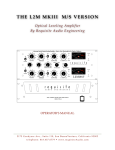Download Universal Audio 4110 Operating instructions
Transcript
Model 2-LA-2 Twin T4 Leveling Amplifier Universal Audio Manual Number 65-1601 Revision 2.01/WS i 2-LA-2 Twin T4 Leveling Amplifier Thank you for purchasing the 2-LA-2 Twin T4 Leveling Amplifier. The 2-LA-2 Takes the best our UA Classics LA-2A reproduction and updates it with modern features, modern components, and a spacesaving design. The original LA-2A was designed by Jim Lawrence and produced in the early 1960s by Teletronix, which was later acquired by Babcock Electronics Corporation. Bill Putnam purchased the design and the name Teletronix from Babcock Engineering in 1967, folding it into his Studio Electronics Corporation. Straightforward in its design, and initially intended for broadcast applications, the LA-2A quickly became standard equipment in studios worldwide. Still a class A, tube-amplified, all discrete design, the 2-LA-2 retains the same key gain reduction components and simple controls, but adds the modern convenience of a stereo matched tool made more versatile for modern studios. As with all optical compressors, the 2-LA-2 works by applying the audio signal to an electro-luminescent light panel which shines on a photo-electric cell which in turn controls the gain. The cadmium-sulfide photo-cells provide a very natural “two-stage, “program dependent” release which results in a very transparent compression characteristic. The 2-LA-2 delivers the same trademark sound of the LA-2A treasured by engineers worldwide. Features • Sound and circuit of the original Teletronix LA-2A • Matched optical T4 modules • Linked stereo or dual mono operation • 2U Rack, Custom UA transformers, audiophile components • Designed by original UREI® engineer Dennis Fink In addition to the 2-LA-2, Universal Audio has released reproductions of the classic Teletronix LA-2A Leveling Amplifier, LA-3A Audio Leveler and 1176LN Limiting Amplifier as well as the 610 tube preamp series of products which are based on those used in the legendary Bill Putnam custom consoles. Modern tools such as the flagship 4110 & 8110 Precision Class-A solid-state microphone preamplifiers bring tonal flexibility to the multi-channel mic preamp. Universal Audio also creates software emulations of vintage hardware and innovative mixing tools that run on our UAD DSP platform. All of these products are designed to meet the demands of the modern recording studio, yet retain the character and quality of vintage equipment. See more at www.uaudio.com, including the award winning 6176 channel strip, the LA-610 all-tube channel strip, SOLO mic pre series, and 2192 Master Audio Interface A/D and D/A. ii IMPORTANT SAFETY INSTRUCTIONS Before using this unit, be sure to carefully read the applicable items of these operating instructions and the safety suggestions. Afterwards keep them handy for future reference. Take special care to follow the warnings indicated on the unit, as well as in the operating instructions. 1. Water and Moisture – Do not use the unit near any source of water or in excessively moist environments. 2. Object and Liquid Entry – Care should be taken so that objects do not fall, and liquids are not spilled, into the enclosure through openings. 3. Ventilation – When installing the unit in a rack or any other location, be sure there is adequate ventilation. Improper ventilation will cause overheating, and can damage the unit. 4. Heat – The unit should be situated away from heat sources, or other equipment that produce heat. 5. Power Sources – The unit should be connected to a power supply only of the type described in the operating instructions, or as marked on the unit. 6. Power Cord Protection – AC power supply cords should be routed so that they are not likely to be walked on or pinched by items placed upon or against them. Pay particular attention to cords at plugs, convenience receptacles, and the point where they exit from the unit. Never take hold of the plug or cord if your hand is wet. Always grasp the plug body when connecting or disconnecting it. 7. Grounding of the Plug – This unit is equipped with a 3-wire grounding type plug, a plug having a third (grounding) pin. This plug will only fit into a grounding-type power outlet. This is a safety feature. If you are unable to insert the plug into the outlet, contact your electrician to replace your obsolete outlet. Do not defeat the purpose of the grounding-type plug. 8. Cleaning – The unit should be cleaned only as recommended by the manufacturer. 9. Nonuse Periods – The AC power supply cord of the unit should be unplugged from the AC outlet when left unused for a long period of time. 10. Damage Requiring Service – The unit should be serviced by a qualified service personnel when: a. The AC power supply cord or the plug has been damaged: or b. Objects have fallen or liquid has been spilled into the unit; or c. The unit has been exposed to rain; or d. The unit does not operate normally or exhibits a marked change in performance; or e. The unit has been dropped, or the enclosure damaged. 11. Servicing – The user should not attempt to service the unit beyond that described in the operating instructions. All other servicing should be referred to qualified service personnel. iii Notice This manual provides general information, preparation for use, installation and operating instructions for Universal Audio’s 2-LA-2. The information contained in this manual is subject to change without notice. Universal Audio, Inc. makes no warranties of any kind with regard to this manual, including, but not limited to, the implied warranties of merchantability and fitness for a particular purpose. Universal Audio, Inc. shall not be liable for errors contained herein or direct, indirect, special, incidental, or consequential damages in connection with the furnishing, performance, or use of this material. Contents This package should contain: 2-LA-2 Twin T4 Leveling Amplifier 2-LA-2 Manual IEC Power Cable Product Registration Card Warranty Warranty for the 2-LA-2 and all Universal Audio hardware is one year, parts and labor. Copyright © 2007 Universal Audio, Inc. All rights reserved. This manual and any associated software, artwork, product designs, and design concepts are subject to copyright protection. No part of this document may be reproduced, in any form, without prior written permission of Universal Audio, Inc. Trademarks 2-LA-2, LA-2A, LA-3A, 1176LN, 2-610, 6176, LA-610, 4110, 8110, 2192, UAD and the Universal Audio, Inc. logo are trademarks of Universal Audio, Inc. Other company and product names mentioned herein are trademarks of their respective companies. iv Table Of Contents Performance and Audio Specifications.................................................................................................... 5 2-LA-2 Operating Instructions................................................................................................................. 2 2-LA-2 Front Panel Channel Controls ...................................................................................................... 2 Peak Reduction ................................................................................................................................... 5 Gain .................................................................................................................................................... 3 Limit / Compress Switch ..................................................................................................................... 3 Gain Reduction / Output Meter............................................................................................................ 3 Meter Adjust........................................................................................................................................ 3 2-LA-2 Front Panel Global Controls ......................................................................................................... 4 Link / Dual........................................................................................................................................... 4 Bypass / Comp.................................................................................................................................... 4 Power .................................................................................................................................................. 5 Rear Panel Connections........................................................................................................................... 5 Input / Output ..................................................................................................................................... 5 Internal Voltage Selector..................................................................................................................... 5 Side-Chain Circuit .............................................................................................................................. 6 AC Power ............................................................................................................................................. 6 Fuse / Mains / Bulbs ........................................................................................................................... 6 Appendixes .............................................................................................................................................. 7 Compressor Basics ............................................................................................................................. 7 Gain Reduction Circuit...................................................................................................................... 10 Sidechain Circuit .............................................................................................................................. 12 Output Circuit ................................................................................................................................... 13 Metering Circuit ................................................................................................................................ 13 Historical Notes ..................................................................................................................................... 14 The 610 Preamp................................................................................................................................ 13 The 1176LN Limiting Amplifier and LA-2A Leveling Amplifier........................................................... 15 The 1176 LN ...................................................................................................................................... 15 The LA-2A.......................................................................................................................................... 16 Performance and Audio Specifications v Gain Reduction Up to 40 dB Maximum Gain 35 +/- 1dB Attack Time 10 ms Release Time 0.06 for 50% release; .5 to 5 seconds for complete release Frequency Response 30 Hz to 15 kHz +/- .1 dB Signal to Noise -70 dBu Distortion Less than 0.35% at +10 dBm, and less than 0.75% at +16 dBm Output Level +20dBu nominal, @ 1% Input Level +24 dBu maximum Input Impedance 600 ohms balanced Output Impedance 600 ohms balanced Tube Complement (2) 12AX7A, (1) 12BH7A, (1) EL84 per channel Fuses 115V usage-1.6 A / 230V usage: 800 mA Power Requirements 110V/220V/100V Power Consumption 80 watts Dimensions 19”W x 3.5”H x 12.25”D 2-LA-2 Weight 14.5 lbs. 1 2-LA-2 Operating Instructions Figure 1: Full view, front panel of the 2-LA-2 The 2-LA-2 is a two channel, vacuum tube amplified, optical compressor utilizing T4 cell gain reduction elements. The 2-LA-2 features linkable sidechains allowing the user to stereo couple the two channels at the flip of a switch. Designed by original UREI® engineer Dennis Fink, the 2-LA-2 retains the original all-discrete Class A and core "sonic signature" components that made the LA-2A the studio standard compressor in recording studios around the world. 2-LA-2 Front Panel Channel Controls Figure 2: 2-LA-2 front panel channel controls Peak Reduction The operation of the 2-LA-2 is very straightforward. The Peak Reduction controls the gain of the side chain circuit (and therefore the threshold of compression) and should be set so that the desired amount of gain reduction is achieved. A moderate compression setting would achieve 3 to 5 dB of gain reduction on the loudest transients. 2 Gain Once the desired Peak Reduction has been set, use Gain to make up any lost signal. The Gain knob controls the final output signal of the 2-LA-2. Limit / Compress Switch The Limit/Compress Switch changes the characteristics of the compressor’s ratio curve. When in the Compress position, the knee is gentler, and presents a low compression ratio, roughly 3:1. A higher limiting ratio with a harder knee results when the switch is set to the Limit position. In practical use, the audible difference between the two settings can be subtle, especially at low Peak Reduction settings. Gain Reduction / Output Meter The VU Meter is used for either output level monitoring or gain reduction monitoring. When used to monitor the output level, set the switch to Output Meter. The meter operates at a standard +4 dB output reading. Set the switch to GR when you wish to view the total gain reduction from the selected channel. In this meter view, the meter normally rests at the 0 dB position when no compression is occurring. Meter Adjust Sometimes fluctuations in the 2-LA-2’s internal operating temperature may cause the Gain Reduction Meter settings to drift. This is a normal occurrence, and part of the charm of vintage style gear. The setscrew on the left side of the meter switch allows the user access to the Gain Reduction Metering calibration. Use a small tip flathead screwdriver to bring the meter back into calibration. 3 2-LA-2 Front Panel Global Controls Figure 3: Front panel global controls Link / Dual Use the Link/Dual switch to easily go between dual mono or stereo linked operation. The Dual position allows the two channels of the 2-LA-2 complete independence from each other. In this position, the 2LA-2 operates as two separate compressors. The Link position achieves a linked sidechain, which causes both channels of the 2-LA-2 to compress on both sides evenly, specifically in the event of loud transient activity on only one channel. The T4 gain reduction cells have been carefully matched to allow the attack and release times of the two channels smooth and musical operation in stereo linked use. Bypass / Comp The Bypass/Comp (Compression) switch allows the user the ability to toggle the gain reduction circuit in or out of the audio path. This is useful in comparing the compressed signal to the non-compressed signal with the flip of a switch. This is also useful if the user wishes to use the 2-LA-2 as an amplifier only, for extra gain or tube coloration without the compression circuit in the signal path. The Bypass/Comp switch is global, and affects both channels of the 2-LA-2, regardless of the Link/Dual switch position. Note: The Bypass function of the 2-LA-2 does not work in the modern sense; it will not recall gain structuring to its original non-compressed position. Therefore, the Bypass position become less practical in extreme gain reduction settings where large fluctuations in gain will occur between the Comp and Bypass positions. Power The 2-LA-2 provides the user with a front panel power switch. It is recommended to power off the unit when the 2-LA-2 is not used for extended periods of time. 4 Rear Panel Connections The rear panel has two identical channels each with Line Input and Line Output connectors. The rear panel also has an AC Power input with a fuse holder. These connectors and controls are discussed in the following sections. Figure 4: Full view, rear panel of the 2-LA-2 Input / Output Standard XLR input and output connectors are provided on the rear panel. Pin 2 is wired positive (hot) on the Line Input, and on the Line Output. Figure 5: Line level XLR input and output connections Internal Voltage Selector The 2-LA-2 can operate at 110V, 220V or 100V. To change the mode, wait 5 minutes after power down, unplug the AC power cord from the rear chassis. Remove the top cover. As shown in Figure 5, there is a connector that can be plugged in to one location or another location to configure the unit for 110V or 220V operation. This figure shows the unit configured for 110V operation. The connector is part of the wiring that comes from the power transformer located at rear center of the 2-LA-2. When changing operating voltage, fuse value must be changed as well. Make sure the 2-LA-2 is properly set for the voltage in your area before applying AC power to the unit! Failure to do so may damage the unit. 5 Figure 5: Operating Voltage Selector AC Power The 2-LA-2 uses a standard, detachable IEC power cable. Fuse / Mains / Bulbs The AC power fuse is located in the AC power connector block. Remove the power cord before checking or changing the fuse. A 1.6 A time delay (slow blow) fuse is required for operation at 115 V. A 800 mA time delay (slow blow) fuse is required for operation at 230 V. A 6.3 V bulb (1847) is used for the power indicator light. 6 Appendixes Compressor Basics Before we dig in to a description of the LA-2A/2-LA-2 circuit, it is useful to examine the general characteristics of compressors and review some terminology. Figure 1 depicts the input/output characteristics of a compressor, an expander and a perfect amplifier. When operated within its specified range, an amplifier provides a constant amount of gain regardless of the level of the input signal. In Figure 1, the middle line depicts a perfect amplifier with a gain of 10 dB. To see this, notice that a signal with an input level of –30 dB will result in an output level of –20 dB, which is an increase of 10 dB. Similarly, an input level of 0 dB will result in an output level of 10 dB, hence the gain stays fixed at 10 dB regardless of the input level. Expansion Perf ect Amplifier +10 Compression 0 Output Level (dB) -10 -20 -30 -30 -20 -10 0 +10 Input Level (dB) Figure 1: Input/output characteristics of a compressor, an expander and a perfect amplifier. In contrast to an amplifier, whose job is to present a constant gain, a compressor varies its gain in response to the level of the input signal. Large input signals result in less gain, thus reducing or “compressing” the dynamic range of the signal. Referring again to the line marked “compression” in Figure 1, we see that an input level of –30 dB results in an output level of –20 dB, indicating a gain of 10 dB. Repeating this for input levels of –20 dB and –10 dB, we see that the compressor exhibits gains of 5 dB and 0 dB respectively. From this, it is clear that the gain decreases as the input signal increases. Referring to the diagram, we see that the compressor will increase its output level by 5 dB for every 10 dB that we increase the input level. The compression ratio is defined as the ratio of these two numbers. In this case the compression ratio would be 10:5, which can be reduced to 2:1. As an aside, an expander is a device which increases the dynamic range of a signal. For example, a 10dB change in the input signal might result in a 20 dB change in the output signal, thus “expanding” the dynamic range. 7 There are several other terms related to compression that can be demonstrated by referring to Figure 2. The amount of compression or gain reduction is typically given in dB and is defined as the amount by which the signal level is reduced by the compressor. Graphically, this can be understood by looking at the difference in levels between what would have been the uncompressed (the output from an amplifier) output level and the compressed output level. This value is what the LA-2A meter displays when it is switched to gain-reduction mode. As mentioned previously, the compression ratio is defined as the ratio of the increase of the level of the input signal to the increase in the level of the output signal. In this example, the input level is increased by 10 dB while the output level only increases 5 dB. This would be a compression ratio of 2:1. Lower ratios such as 2:1 result in more gentle compression. (Note that a compression ratio of 1:1 is no compression at all). Typically, compressors let you choose a threshold. This is the point at which gain reduction starts to take place. When an audio signal is below this threshold the compressor acts like an amplifier and there is no gain reduction. Above the threshold the slope becomes less than 45 degrees, indicating gain reduction and hence compression. The point at which a compressor transitions into compression is commonly called the knee. In practical compressors, this transition is gentler than what is depicted in the diagram. Many modern compressors provide a control which adjusts the threshold directly. In the case of the LA-2A, the Peak Reduction knob controls both the threshold and the amount of compression. Compression Region 10 dB of Compression +10 0 Output Level (dB) 2:1 Compression -10 -20 Knee -30 -30 -20 -10 0 +10 Input Level (dB) Figure 2: Input/output curve of a compressor with a ratio of 2:1 and a threshold of -20 dB. 8 Figure 3: Block diagram of the LA-2A compressor 9 A functional block diagram of the LA-2A is provided in Figure 3. A brief overview of the operation will be provided here. The input transformer provides isolation and impedance matching. After this the signal is fed into both the side-chain circuit and the gain reduction circuit. The side-chain is comprised of a voltage amplifier, a pre-emphasis filter, and a driver stage, which provides the voltage necessary to drive the electro-luminescent panel. This signal controls the gain of the compressor. After the gain reduction circuit, the signal is sent through an Output Gain control and a two-stage output amplifier, followed by the output transformer. Electro-Luminescent Panel Photo-Electr ic Cell Figure 4: Diagram of the T4 electro-optical cell Gain Reduction Circuit As mentioned previously, compressors are devices that vary their gain in a manner that is dependent upon the level of the input signal. In order to do this, the compressor must first have some method of determining the level of the signal, and must then be able to use this to control the gain. There are many different schemes to accomplish these tasks. In the case of the LA-2A, both of these functions are performed by the T4, which is an electro-optical element. A T4 is comprised of an electro-luminescent (EL) panel and a photoelectric cell. The EL panel is essentially a night-light. As you would expect, the larger the signal that is applied to it, the brighter the light that is generated. This light shines upon the photoelectric cell. A photoelectric cell is a light sensitive device whose resistance changes depending upon the intensity of light to which it is subjected; the brighter the light, the less resistance the photocell will have. As depicted in Figure 5, the photocell is used to control the gain of the circuit. Essentially, the photocell acts as the bottom leg in a voltage divider circuit. The lower the resistance of the photocell, the lower the signal voltage will be at the output of the gain reduction stage. To see why this is true, we can look at the extreme cases. If the resistance is extremely high (this is the case when there is a small input signal and the light is off) then the photocell does not affect the circuit and there is no gain reduction. The second case we can look at is when there is a large signal present. In this condition, the light shines brightly and the photocell exhibits very low resistance. If the resistance of the photocell becomes zero (a dead short), then the signal would be grounded and there would be no 10 output. In reality, the photocell resistance cannot go completely to zero, hence there will always be some signal present. HA-100X 7 R6 R7 68K 2.7K GAIN R1 TO VOLTAGE 100K AMPLIFIER 9 8 R5 68K TO GAIN REDUCTION CONTROL ELECTROLUMINESCENT ELEMENT .0047 uF 10 PHOTOCONDUCTIVE CEL TO ATTENUATOR DRIVE AMPLIFIER Figure 5: Schematic of the LA-2A input and gain reduction circuit. The T4 electro-optical device is the heart of the compressor and its gain reduction characteristics. Its unique characteristics affect the overall sound and character of the LA-2A. In addition to the compression curve, the combination of the EL panel and the photocell determine the attack and release characteristics of the LA-2A. This is one of the most important contributors to the sound of the LA-2A. Unlike other compressors which allow the user to adjust these parameters, the attack and release of the LA-2A are completely determined by the T4. There are several important characteristics of the T4 which play crucial roles in the sound of the LA2A. The first is the attack. The LA-2A was the first electro-optical compressor to use an electroluminescent panel for the light source. Previous attempts at electro-optical compression employed either neon or incandescent lights. Both of these took time to light up, and this delay resulted in slow attacks. The electro-luminescent panel resulted in a faster attack than exhibited by other contemporary devices. The next important aspect is that of the release of the compressor. This is determined almost entirely by the characteristics of the photocell. The LA-2A uses cadmium-sulfide photocells. The first important aspect of the cell is its “two-stage decay”. After the light is removed from the cell, it releases quickly (40-80 milliseconds) to approximately half of its off resistance. The remainder of its release can take place over as much as several seconds. The next aspect is the “memory” of the cell. This results in two important aspects of the character of the LA-2A. The amount of time it takes for the cell to recover after the light is removed depends on how long light had been shining on it and how bright the light. In the case of the LA-2A this results in behavior where the release time is slower if the unit has either been in compression for a while, or the amount of compression is large. This “program dependent” release characteristic is critical to the sound of the unit. 11 The amount of compression, as well as the compression threshold, is controlled by the Peak Reduction potentiometer. This potentiometer controls the gain of the side-chain circuit. The greater the gain of this circuit, the lower the threshold and the greater the amount of compression will be. Many modern limiters and compressors allow for the direct adjustment of the threshold. Other units such as the 1176LN use a fixed threshold and provide an input level control, which adjusts the signal level before it is applied to the compression circuit. In contrast, the LA-2A, while also having a fixed threshold, does not control the input level, but rather controls the amount of side chain gain applied to the input signal. POWER SUPPLY OUTPUT INPUT STEREO PARALLEL ATTENUATOR DRIVE-AMPLIFIER R37 R34 22K 2W C11 R35 .1 220K 1 Meg LIM RESP R33 220K C12 .001 V4 C9 C6 .02 .01 R32 R3 STEREO 1M ADJ R2 100K 1K 6AQ5A R30 47K V3A V3B 12AX7A C8 .03 C7D 30 uF R36 1K C10 R31 1K 50 uF Figure 6 : Schematic diagram of the LA-2A side-chain circuit Sidechain Circuit The previously described gain reduction circuit is controlled by the control voltage which is supplied by the sidechain circuit. The LA-2A is a feedback style compressor. This is due to the fact that the signal that is used to drive the sidechain circuit is affected by the gain-reduced signal. This signal is first fed into the Peak Reduction potentiometer (R2), which controls the amount of side-chain drive and in turn controls the compression threshold and amount of gain reduction. A 12AX7 is then used as a voltage amplifier to increase the signal level. A pre-emphasis circuit is provided on the output of the 12AX7. Originally designed for broadcast, the LA-2A allowed for side-chain equalization, which allowed the operator to make the compression more or less sensitive to the voice frequency bands. For musical applications, this equalization is usually set to a flat frequency response. Subsequent to the filter, a 6AQ5/EL84 provides the signal necessary to drive the electro-luminescent panel. EL panels were often used for night-lights and hence are usually designed to be driven with 120 volts, 60 Hz AC. They were not designed for audio, and applying the wide-bandwidth signals that arise in audio applications results in a shortened lifetime of the part. 12 Output Circuit The output circuit is comprised of a 12AX7, which operates as a voltage amplifier followed by a 12BH7A, which operates as a cathode-follower. This is followed by the output transformer, which provides impedance matching and a balanced output. R16 68K VOLTAGE AMPLIFIER CATHODE FOLLOWER R16 C7C R9 220K V1A 30uF .1 68K R13 220K C1 R17 10K C2 .02 V1B R21 100K .1 C3 .1 R10 1.5K R12 470K C5 A-24 V2A FROM R1 R11 68K C2 10 uF 1 12AX7 R14 2.7K R15 470K R18 1K 2 4 3 V2B 5 12BH7 R20 1K R19 470K 8 Figure 7: Schematic diagram of the LA-2A output circuit Metering Circuit The metering circuit in the LA-2A has 3 modes selected by a front-panel switch, allowing for output level monitoring at +4 and +10 dB as well as gain reduction (The 2-LA-2 has only +4). As mentioned previously, the gain reduction is controlled by the photocell in the T4 el-op. In order to track the operation of this cell and determine the gain reduction, the same EL panel also illuminates a second photocell. This photocell is hand-selected to match the gain reduction photocell and hence gives an accurate indication of the amount of compression. 13 Historical Notes Bill Putnam Sr. was awarded the 2000 Technical Grammy for his multiple contributions to the recording industry. He was highly regarded as a recording engineer, studio designer/operator and inventor. Putnam was considered a favorite of musical icons including Frank Sinatra, Nat King Cole, Ray Charles, Duke Ellington, Ella Fitzgerald and many, many more. The studios he designed and operated were known for their sound and were an experimentation ground for his continuing desire to push the envelope. Universal Recording in Chicago, United and Western in Los Angeles (now Ocean Way and Cello) all preserve elements of his room designs. The companies Putnam started, Universal Audio, Studio Electronics, and UREI, built products that are still in regular use decades after their development. In 1999 Bill Jr. and James Putnam re-launched Universal Audio and merged with Kind of Loud technologies – a leading audio software company – with two goals: Reproduce classic analog recording equipment designed by their father and his colleagues, research and design new recording tools in the spirit of vintage analog technology. Today Universal Audio is fulfilling that goal, bridging the worlds of vintage analog and DSP technology in a creative atmosphere where musicians, audio engineers, analog designers and DSP engineers intermingle and exchange ideas every day. Analog or digital, UA remains committed to the “hand assembled” ideal that has been forgotten by many audio manufacturers. Whatever the endeavor, every project taken on by the UA team is driven by its historical roots and a desire to wed classic analog technology with the demands of the modern digital studio. The 610 Preamp UA’s 610 line of products were inspired by the Putnam-designed 610 console built in 1960 for his United Recording facility at 6050 Sunset Boulevard in Hollywood (now Ocean Way). As was the case with most of Putnam’s innovations, the 610 was the pragmatic upshot of a recurring problem in the studio: how to fix a console without interrupting a session. The traditional console of the time was a one-piece control surface with all components connected via patch cords. If a problem occurred, the session came to a halt while the console was dismantled. Putnam’s solution was to build a mic-pre with gain control, echo send and adjustable EQ on one modular chassis using a printed circuit board. While modular consoles are commonplace today, the 610 was quite a breakthrough at the time. While the 610 was designed for practical reasons, it was aesthetic appeal that made it popular with the recording artists who frequented United and Western in the 60’s. The character of the mic-pre in particular made it favorite of engineers like Bruce Swedien, Bruce Botnick, Lee Hershberg and Jack Joseph Puig; and artists including Sarah Vaughan, Frank Sinatra, Ray Charles, and The Beach Boys. Swedien describes the character of the preamp as “clear and open” and “very musical”. Studios 2 and 3 at Western, which featured the 610 console, were the site of many classic recordings of the 60’s, including the Mamas and the Papas (Bones Howe), Up, Up and Away by the Fifth Dimension, Herb Alpert, Sergio Mendes (Bruce Botnick), and of course Pet Sounds. 14 Legendary engineer Wally Heider, manager of remote recording at United, used his 610 console to record many live recordings including Peter, Paul and Mary “In Concert” (1964), Wes Montgomery’s “Full House” (1962), and all of the Smothers Brothers Live albums. Heider’s console was later acquired by Paul McManus in 1987, who spent a decade restoring it. [We thank Paul for his efforts and his contribution to our efforts to trace the history of the 610.] At least one 610 module is still in use at Ocean Way. Allen Sides, who purchased the studio from Putnam to open Ocean Way, personally traveled to Hawaii to collect the 610 console that was used to record the live “Hawaii Calls” broadcasts. Jack Joseph Puig has been ensconced in Studio A with the 610 (and a stunning collection of vintage gear) where he has applied the vintage touch to acts including Beck, Hole, Counting Crows, Goo Goo Dolls, No Doubt, Green Day and Jellyfish. The 1176LN Limiting Amplifier and LA-2A Leveling Amplifier The LA-2A and 1176 compressor/limiters long ago achieved classic status. They're a given in almost any studio in the world — relied upon daily by engineers whose styles range from rock to rap, classical to country and everything in between. With so many newer products on the market to choose from, it's worth looking at the reasons why these classics remain a necessary part of any professional studio's outboard equipment collection. The basic concept of a compressor/limiter, is of course, relatively simple. It's a device in which the gain of a circuit is automatically adjusted using a predetermined ratio that acts in response to the input signal level. A compressor/limiter "rides gain" like a recording engineer does by hand with the fader of a console: it keeps the volume up during softer sections and brings it down when the signal gets louder. The dynamic processing that occurs at ratios below 10 or 12 to one is generally referred to as compression; above that it's known as limiting. Modern day compressors offer a great degree of programmability and flexibility while older devices such as the 1176 and the LA-2A are more straightforward in their design. Perhaps it is this fact that has contributed to their appealing sound and the longevity of their popularity. The 1176LN The original Universal Audio 1176LN was a major breakthrough in limiter technology – the first true peak limiter with all transistor circuitry offering superior performance and a signature sound. Evolved from the popular Universal Audio 175 and 176 vacuum tube limiters, the 1176LN retained the proven qualities of these industry leaders, and set the standard for all limiters to follow. It was Bill Putnam himself who, in 1966, was responsible for the initial design of the 1176. Its circuit was rooted in the 1108 preamplifier, which was also designed by Putnam. As is evident from entries and schematics in his design notebook, he experimented with the recently developed Field Effect Transistor (F.E.T.) in various configurations to control the gain reduction in the circuit. He began using F.E.T.s as voltage variable resistors, in which the resistance between the drain and the source terminals is controlled by a voltage applied to the gate. His greatest challenge was to ensure that distortion was minimized by operating the F.E.T.s within a linear region of operation. After several unsuccessful attempts at using F.E.T.s in gain reduction circuits, Putnam settled upon the straightforward approach of using the F.E.T. as the bottom leg in a voltage divider circuit, which is placed ahead of a preamp stage. 15 The output stage of the 1176 is a carefully crafted class A line level amplifier, designed to work with the (then) standard load of 600. The heart of this stage is the output transformer, whose design and performance is critical. Its primary function is to convert the unbalanced nature of the 1176 circuit to a balanced line output, and to provide the proper impedance matching to drive the line impedance of 600. This transformer is critical due to the fact that it uses several additional sets of windings to provide feedback, which makes it an integral component in the operation of the output amplifier. Putnam spent a great deal of time perfecting the design of this tricky transformer and carefully qualified the few vendors capable of producing it. The first major modification to the 1176 circuit was designed by Brad Plunkett in an effort to reduce noise--hence the birth of the 1176LN, whose LN stands for low noise. Numerous design improvements followed, resulting in at least 13 revisions of the 1176. The D and E 'black-face' LN revisions are widely considered to be the best-sounding models; therefore Universal Audio modeled our reissue after these two models. The LA-2A The LA-2A leveling amplifier, a tube unit with hand wired components and three simple controls, was introduced in the early 1960s. It utilized a system of electro-luminescent optical gain control that was quite revolutionary; gain reduction was controlled by applying the audio voltage to a luminescent driver amplifier, with a second matched photoconductive cell used to control the metering section. With its 0 to 40 dB of gain limiting, flat frequency response of 0.1 dB from 30-15,000 Hz and a low noise level (better than 70 dB below plus 10 dBm output,) the LA-2A quickly became a studio standard. Originally patented by Jim Lawrence, it was produced by Teletronix in Pasadena, California, which became a division of Babcock Electronics Corp. in 1965. In 1967 Babcock's broadcast division was acquired by Bill Putnam’s company, Studio Electronics Corporation shortly before he changed the company’s name to UREI®. Three different versions of the LA-2A were produced under the auspices of these different companies before production was discontinued around 1969. 16 Notes 17






















